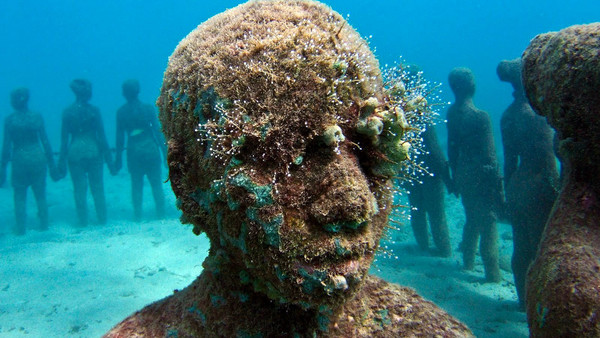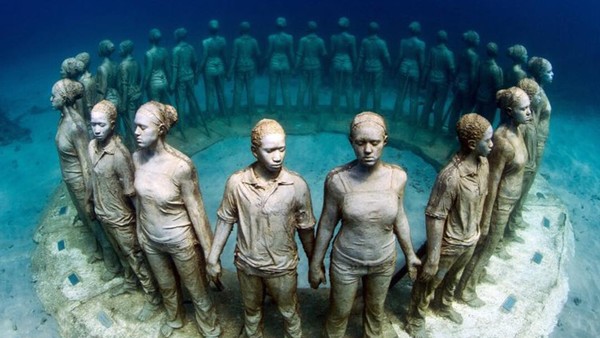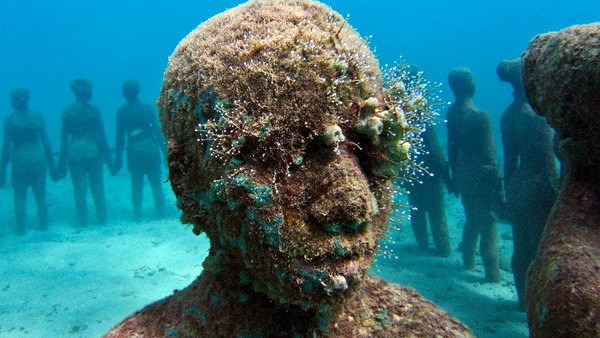Most Bizarre Underwater Discoveries Nobody Can Explain

Given that around 70% of our planet is covered in water, it’s hardly surprising that untold mysteries and amazing phenomena have been discovered beneath the waves, from ancient shipwrecks to thriving ecosystems.
The modern age of deep-sea exploration dates back to the late 1700s when French scientist Pierre Simon de Laplace calculated the depth of the Atlantic by measuring tidal motions on the Brazilian and African coasts, but it took mankind several centuries to truly conquer the oceans, and even now much of their depths remain uncharted.
In 1960, a research bathyscaphe called the Trieste became the first manned vessel to reach the bottom of the Challenger Deep in the Pacific Ocean’s Mariana Trench near Guam, the deepest known point in the Earth’s seabed hydrosphere.
This was a milestone for deep-sea exploration, but the discoveries haven’t stopped there, with researchers having stumbled upon all kinds of weird and wonderful phenomena, not just in our oceans, but the depths of our rivers and lakes too.
From mysterious stone structures, to lifeforms that don’t play by the usual rules, here are the most bizarre and mysterious things ever found during deep dives.
Honourable Mention: A Sunken Sculpture Park

Though not strictly unexplained (and hence why it’s included as an honourable mention only), this entry was just too intriguing not to include.
The deep-sea gallery of sculptures in the Molinere Beausejour Marine Protected Area of the Caribbean Sea, off the coast of Grenada, gets an honourable mention for inspiring no less awe than some of mankind’s more mysterious aquatic discoveries.
Located between four and five metres deep, the collection of statues is designed to enhance a conserved section of the ocean and highlight the way nature makes a permanent mark on the physical world over time.
Many of the sculptures, which includes life-sized casts of local children, are covered in sea vegetation and barnacles, and have been a hit with scuba enthusiasts for years.
The artwork has also encouraged marine life to take up residence in this stretch of the Caribbean Sea and thus proved beneficial to the environment.
6. An Aquatic Stonehenge

A strange stone formation with more than a passing resemblance to Great Britain’s Stonehenge lies at the bottom of Lake Michigan. The monoliths’ origins are unknown, but they are thought to be thousands of years old.
The site was uncovered by Mark Holley, a professor of underwater archaeology at Northwestern Michigan University College, and his colleague Brian Abbot in 2007 while they crossed the lake in a ship loaded up with sonar equipment, but the discovery has thrown up more questions than answers over the years.
The plot thickened when a carving of a mastodon, a distant relative of the elephants that’s been extinct for over 10,000 years, was discovered on one of the pillars, suggesting its origins could stretch all the way back to the last ice age.
A similar monolith has also been discovered in Europe, this time in salt water off the coast of Sicily, although experts believe these stones once served as a primitive form of lighthouse technology, illuminating the way for seafarers in a bygone age.
5. The Yonaguni Complex

The underwater complex of Yonaguni has been one of Japan’s great aquatic mysteries since dive tour operator Kihachiro Aratake stumbled upon it back in 1985.
This ancient structure, which is submerged off the southern coast of the Ryukyu Islands, has sparked heated debate among archaeologists and researchers, who are unable to agree whether it’s man-made or a natural formation.
One school of thought is that the Yonaguni complex is all that is left of Mu, a fabled Pacific civilization said to have vanished beneath the ocean in the distant past.
The formation, which is made up of fine sandstone and mud-stone, has been referred to as Japan’s Atalantis and may actually be millions of years old.
4. Long Lost Locomotives

When Paul Hepler, the captain of the charter boat Venture III, was mapping out the ocean floor off the coast of New Jersey in 1985, he made a bizarre discovery. Sat perfectly upright on the seabed, around 90 feet down, were two rare locomotives.
Subsequent dives revealed the trains to be Planet Class 2-2-2 T models, some of the oldest steam trains ever built in the United states, but how they ended up at the bottom of the sea is anybody’s guess.
More than 20 dives and countless hours of research have been invested in the so-called New Jersey deep-sea train graveyard, yet their full origin remains a mystery.
There have been countless theories on this very subject, the most likely explanation being that they blew off a transportation ship during a storm, but since there’s no record of them being lost, this idea has to be filed under ‘speculation’ for now.
3. The Bimini Road

One of the most popular tourist attractions in the Bahamas is the Bimini Road, a mysterious pathway running 20ft beneath the ocean’s surface.
Its origins are shrouded in mystery and most experts fail to agree whether the road is man-made or the result of Mother Nature’s tinkering.
There have been a number of outlandish theories about its purpose over the years, with some even speculating that it leads to the ruins of the mythical city of Atlantis.
The Bimini Road was fist discovered in the 1930, and this is the best (or at least the most fun) explanation for its existence that has been tabled so far. It’s been a popular sight for scuba enthusiasts since it was uncovered.
2. The Baltic Sea Anomaly

More than 90 metres beneath the waves of the Baltic Sea lies a weird object that resembles the Millennium Falcon from the Star Wars movies.
Referred to as the Baltic Sea Anomaly, the strange circular entity was discovered by Swedish explorer Peter Lindberg and his Ocean X team in June 2011.
Conspiracy theorists leaped on the find and hailed it as proof aliens have visited Earth, and for five years, few other explanations for the phenomenon presented themselves.
This year, scientists from Stockholm University carried out analysis on samples carved from the Baltic Sea Anomaly and concluded that it is simply a glacial deposit, but Lindberg isn’t satisfied with that conclusion, pointing out that it doesn’t explain why all of his electrical equipment cut out when he arrived in the object’s vicinity.
1. An Ancient Underwater City

The remains of what marine scientists described as a “huge lost city” were discovered 36 metres underwater in the Gulf of Cambay off the coast of India back in 2002.
Relics of ancient civilisations have turned up beneath the waves countless times before, but what really surprised researchers this time is that initial estimates put the submerged ruins at around 9,500 years old.
That’s thousands of years before the region was thought to contain people, so historians were at a loss to explain the discovery and were forced to reassess everything they thought they knew about the area.
Debris recovered from the site included construction material, pottery, sections of walls, beads, sculpture and even human remains, which were carbon-dated and found to predate the 4,000-year-old Harappan civilisation.




































































